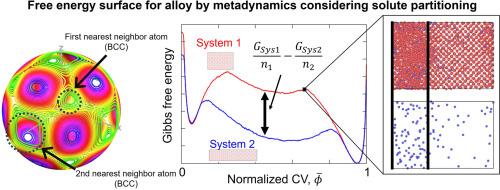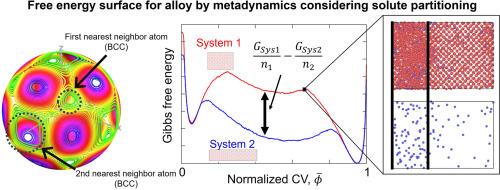二元合金固液共存体系的元动力学
IF 9.3
1区 材料科学
Q1 MATERIALS SCIENCE, MULTIDISCIPLINARY
引用次数: 0
摘要
提出了一种新的元动力学方法来精确模拟二元合金中溶质分配行为和确定固液界面能。该方法通过修正集体变量(CV)的定义,提高了高温下体心立方(BCC)晶体结构的识别能力。通过对两种不同尺寸但成分相同的体系进行元动力学模拟,由自由能面差确定固液界面能。由于两种体系固液相化学势相同,固液界面产生的多余能量与混合自由能明显分离。该方法应用于Fe-C合金,在研究温度范围内,界面能与碳浓度没有明显的相关性。此外,该方法还应用于几种替代BCC和面心立方(FCC)合金,证明了该方法的通用性和在其他合金中的广泛应用潜力。从热力学角度讨论了固液共存状态下FES凸向下位移的原因。本研究通过提供热力学论证,有助于理解合金系统的元动力学。本文章由计算机程序翻译,如有差异,请以英文原文为准。


Metadynamics for solid-liquid coexistence system of binary alloys
A new metadynamics-based method is proposed to accurately model solute partitioning behavior and determine the solid-liquid interfacial energy in binary alloys. The method improves the identification of body-centered cubic (BCC) crystal structure at high temperatures by revising the definition of the collective variable (CV). The solid-liquid interfacial energy is determined from the free energy surface (FES) differences by performing metadynamics simulations on two systems with different sizes but identical compositions. The excess energy due to the solid-liquid interface was clearly separated from the free energy of mixing thanks to the identical chemical potential of solid and liquid phases in these two systems. The method is applied to Fe-C alloys, where no significant dependence of interfacial energy on carbon concentration is observed within the investigated temperature range. Moreover, the method is applied to several substitutional BCC and face-centered cubic (FCC) alloys, demonstrating its versatility and potential for broader application to other alloys. The origin of the convex downward shift in the FES at the solid-liquid coexistence state is discussed from a thermodynamic perspective. This study contributes to the understanding of metadynamics in alloy systems by providing a thermodynamic justification.
求助全文
通过发布文献求助,成功后即可免费获取论文全文。
去求助
来源期刊

Acta Materialia
工程技术-材料科学:综合
CiteScore
16.10
自引率
8.50%
发文量
801
审稿时长
53 days
期刊介绍:
Acta Materialia serves as a platform for publishing full-length, original papers and commissioned overviews that contribute to a profound understanding of the correlation between the processing, structure, and properties of inorganic materials. The journal seeks papers with high impact potential or those that significantly propel the field forward. The scope includes the atomic and molecular arrangements, chemical and electronic structures, and microstructure of materials, focusing on their mechanical or functional behavior across all length scales, including nanostructures.
 求助内容:
求助内容: 应助结果提醒方式:
应助结果提醒方式:


